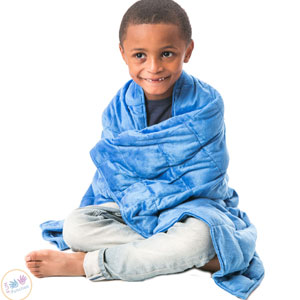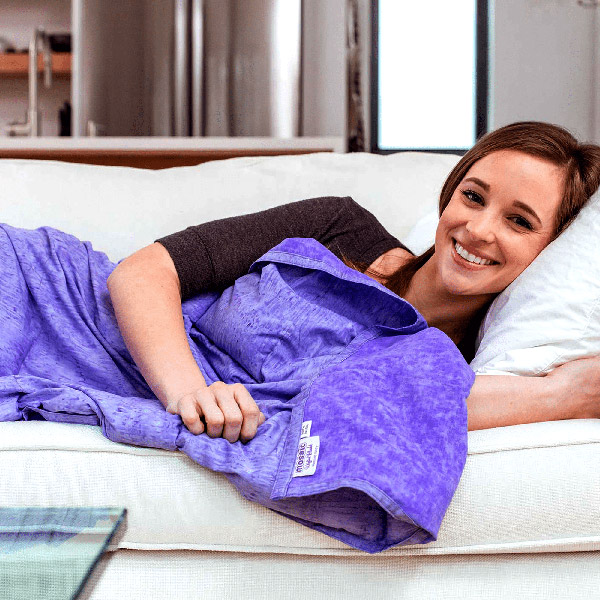Understanding Weighted Blanket Therapy: How Does It Work?
For transparency, I wanted to let you know that this page contains affiliate links. What is an affiliate link? In a nutshell, as an Amazon and Shareasale affiliate if you make a purchase after clicking a link on this site, I may receive a small commission, at absolutely no extra cost to you! Why do I have affiliate links on my site? Running a site like this and producing quality free content can be surprisingly time and resource intensive. Earning some affiliate income allows me to offset and justify the time and cost involved in producing content, paying for hosting, maintaining the site etc.
If you are considering a weighted product for yourself, a friend, family member or child: Please make sure you are well educated on the right weight to use, and whether use of a weighted product would be safe in your specific situation. If you are at all uncertain, please consult a qualified medical practitioner. Material provided on this site is for general informational purposes only and should not be considered a substitute for qualified medical advice (more info about that here).
Weighted blanket therapy has been gaining more popularity these days. From anxiety and sleep disorders to autism and sensory processing disorders, weighted therapeutic products boast incredible benefits.
The first thing you need to know about weighted blanket therapy, is that there are no real established guidelines for occupational therapists to pick the right weight and size for each individual’s condition, therefore, it can be a rather personal consideration of the therapist after knowing about the specific case, whether to know if weighted blanket therapy is an adequate treatment.
That said, some therapists would also recommend having trials first with different weights, to assess the right one for the patient, so if you can get a trial from the manufacturer that would be really helpful for picking the right one for your specific needs.
If you can’t get a trial you could look for a manufacturer that has the feature of adding/removing weight from their product, to make it more flexible for treatment. Or you can look at some interesting ideas we provide in this article.
The Uses of Weighted Blanket Therapy
The even pressure of a heavy blanket has been shown to promote deep pressure touch stimulation. When used regularly, a weighted quilt can become a part of an effective therapy that has a soothing, calming effect on your mood.
Although weighted blanket therapy is used to relieve the symptoms of autism and sensory processing disorders, healthy people can benefit from it too.
Daily stress and fatigue can negatively affect your sleep and mood. This is where you can opt for the therapy.
This study by the University of Massachusetts, showed that the use of weighted comforters helped to significantly reduce the stress levels, regulate blood pressure, and tame anxiety symptoms on acute inpatient mental health adults.
Plus, it has positive calming effects on people with the obsessive-compulsive disorder, ADHD, and post-traumatic stress disorder.
You can use a heavy blanket on top when lying down or drape it over when standing or sitting (if it’s not one of the really heavy ones). Furthermore, you must know that everyone has different sensory preferences and needs, so find out what works best for you.
The same applies to children. You can wrap your little one in the weighted quilt like a burrito (just don’t leave him like that for too long), lay it flat on top of them, or drape it over the shoulders. When your child needs a deep touch pressure input, a heavy blanket can easily be great for the therapy.
If you’re interested in purchasing a weighted blanket for therapy, check out these popular options:
Image | Name | Fabric | Filler | Decorations | Prices & Details |
|---|---|---|---|---|---|
Moonbow | Bamboo and polyester | Micro Glass beads | 2 colors | ||
Fun and Function | Soft Plush cotton / polyester | Polypropylene pellets | 1 color | ||
Luxome | Ultra plush minky or luxury bamboo | Glass beads (certified lead free) | Many colours available | ||
Mosaic Weighted Blankets | Cotton, minky and textured fabric choices | FDA compliant plastic pellets | Widest range of colors and patterns |
Occupational Therapy: How Does It Help?
Occupational therapy (OT) is a treatment that helps people with a cognitive, sensory, or physical disability to be as independent and productive as possible, in different areas of their lives.
Not only does occupational therapy help people improve their sensory, physical, and cognitive skills, but also boosts their sense of accomplishment and overall self-esteem.
Depending on the condition or health issue, OT helps to:
- Overcome disabilities by learning how to improve your condition and do daily tasks with the abilities you have.
- Adapt the things you’ve used to use around the house, work, gym, or while driving or traveling.
- Make the necessary changes to the environments to encourage comfortable and healthy living.
OT practitioners also focus on social and psychological factors that can affect functioning in various ways. Occupational therapy is good for kids and adults alike.
Occupational Therapy Tools
There are countless occupational therapy tools that promote recovery and improve the quality of life. These tools are divided into a few categories and can be used in the school, workplace, or at home.
- For creating a sensory area: body socks, textured cubes, kinetic sands, mini trampolines, bean bag chairs, etc. They all have a calming effect and enhance emotional, concentration, and attention control.
- For environmental support: light filters and noise cancelling headphones.
- Oral sensory tools: chew bricks, chewelry bracelets and necklaces, and other chewy products.
- Weighted items: weighted lap pads, vests, blankets, shoulder wraps, and stuffed animals.
- Transition tools: time trackers and timers.
- Fidgets: tangles and fidgipods.
- Seating tools: rocker chairs, wiggle cushions, wobble chairs, tactile sensory balls, and regular exercise balls.
- Handwriting tools: finger spaces, slant boards, pencil weights, and writing rascals.
Deep Pressure Therapy
Deep pressure therapy (DPT) is a firm tactile sensory input that aids in providing proprioceptive input to the entire body.
The therapy can include the weighted and sensory products that imitate firm hugs, cuddling, strokings, hugging, squeezing, swaddling, or compression.
When administered to the entire body, DPT has an organizing, calming effect on adults and kids alike. The therapy is recommended for people with sensory processing disorder, psychiatric disorders, autism spectrum disorder, and attention deficit disorder.
Occupational therapists use DPT to relieve the symptoms of many disorders. The most common DPT activities are:
- Joint compressions.
- Deep massages.
- Bear hugs.
- Sleeping or napping under a weighted blanket.
- Wearing of compression garments or weighted vests.
- Deep vibration to the entire body.
- Rolling a therapy ball firmly on top of the trunk, arms, or legs.
- Squishing between two soft pillows.
- Wrapping/rolling firmly in a blanket to create a “burrito”.
- Deep pressure seating.
- Climbing under sofa cushions.
- Using a therapeutic squeeze machine.
- Using a deep touch pressure service dog.
DPT helps to:
- Reduce stress and anxiety.
- Increase focus and attention.
- Improve sleep.
- Improve coordination.
- Boost body and spatial awareness.
- Improve proprioceptive processing for an increased balance.
Sensory Integration Therapy
Sensory integration (SI) therapy helps children with sensory processing problems by exposing them to a sensory stimulation in a rigidly structured and repetitive way. Thanks to the therapy, a child’s brain adapts, allowing them to process and respond to sensations better.
SI therapy is often provided by occupational therapists, as they developed a range of activities to help child’s nervous system to react to sensations and movements, in a more “organized” way.
In this study by OT Roseann C. Schaaf, a team of OTs found that sensory integration therapy improves everyday function in kids with autism. The study suggested that SI therapy helps to more efficiently process sensory information like textures, smells, sounds, tastes, movement, and brightness.
How does it work?
During SI therapy, a child interacts with the occupational therapist and does a number of activities that combine motion with sensory input. Some of the commonly used activities are:
- Balancing on a beam (improving balance).
- Hitting swinging balls (working on eye-hand coordination).
- Crawling through tunnels (learning touch and movement in synchrony through space).
- Laying in a box filled with seeds, lentils, or beans (improving touch sensation).
- Dancing to music (working on sound).
- Swinging in a hammock (learning movement through space).
The therapy is challenging and stimulating and the key is to focus on the integration of movement with the various senses. When done correctly, the therapy ensures that a child will be able to learn, play, and interact with others and surroundings.
How Often Should I Use My Weighted Blanket
This is an easy one, because weighted blankets are safe and designed to be used whenever you want to (as long as you pay attention to your occupational therapist's recommendations on the weight). You can use them multiple times throughout the day, not only while you are sleeping.
Great results have been achieved by using heavy blankets during the night, on the couch, while you watch tv, or even utilizing weighted lap pads while you work at the computer or are sitting down for long periods of time.
How Can Weighted Products Help with SI therapy?
Occupational therapists often use weighted products, such as blankets, lap pads, vests, and stuffed animals, to make each session more comfortable for a child. Some children also have trouble performing certain activities, so heavy tools can be helpful.
The weighted products relax the body and calm down the central nervous system, helping a child to integrate sensory information more efficiently. Therefore, a child is more organized and able to concentrate better on the activity they should perform during SI therapy.
Weighted blanket therapy has many benefits, but remember that it can’t cure all the health woes. But at least, it has little to no side effects, so it’s definitely worth trying if a doctor recommends.





